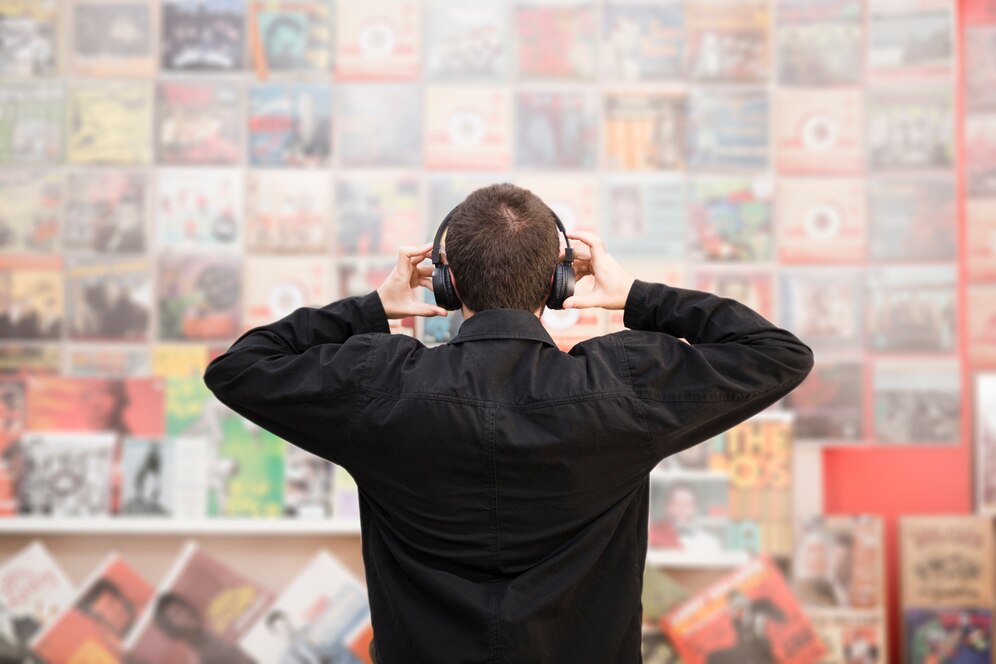
- October 17, 2023
- Entwy Editorial Team
- 0
Tuning Into Inspiration: Music Trends and Strategies for Every Mood
Music deeply affects our feelings, and the right tunes can lift our spirits. The bond between music and emotions is intricate. It helps us choose the songs that match our mood.
From lively tracks that energize us to soft melodies that calm our minds, music shapes our emotions. Exploring different genres can lead us to new artists and songs that touch our hearts.
Music’s power to change our mood is undeniable. It can boost our energy or soothe our souls. With so many songs out there, we can create playlists that match our feelings. This way, music becomes a tool for better mental health and happiness.
Key Takeaways
- Music has a profound impact on our emotions and can elevate our mood.
- Different music genres have distinct effects on our emotions.
- Understanding the connection between music and emotions can help us make informed choices about the music we listen to.
- Music can be used as a tool to improve our mental health and well-being.
- Curating playlists that cater to our unique moods and preferences can enhance our emotional experiences.
- Exploring the diverse world of music can help us discover new genres and artists that resonate with our emotions.
The Science Behind Music and Emotions
Music deeply affects our feelings, and research shows it can make our brains release happy chemicals. This is thanks to music theory, which explains how different parts of music can make us feel different ways. Experts from psychology, neuroscience, and music theory work together to understand music’s emotional power.
Emotional resonance is a key idea in this field. It’s about how certain sounds can make us feel certain emotions. For instance, slow, minor music can make us feel sad and calm. On the other hand, fast, major music can make us feel more energetic and excited. This knowledge helps in creating music therapy and personalized music suggestions.
- The brain’s default mode network is active when listening to music, which can lead to mind-wandering and introspection.
- Music with a strong rhythmic pulse can increase feelings of energy and motivation.
- Listening to music that evokes positive emotions can improve mood and reduce stress.
These discoveries show how complex and varied music’s emotional effects can be. They also stress the need to look at the psychological and neurological sides of how we feel music.
| Emotional Response | Musical Element |
|---|---|
| Sadness | Slow tempo, minor key |
| Energy | Fast tempo, major key |
| Relaxation | Slow tempo, calming melody |
Different Music Genres and Their Emotional Impact
The music industry knows how music genres affect us. From classical to rock, each has its own feel. Classical music brings out sophistication, while rock music is all about energy and rebellion.
Genres like jazz and blues touch our souls, making us feel melancholy and nostalgic. On the other hand, hip-hop and pop make us feel confident and joyful. The way music makes us feel can change based on where we are from.
Knowing how music genres make us feel is key for artists. It helps them create songs that connect with people. As music changes, it will be exciting to see how genres and feelings shape the future.
Here are some examples of music genres and their emotional impact:
- Classical music: sophistication, elegance
- Rock music: energy, rebellion
- Jazz and blues: soulfulness, introspection
- Hip-hop and pop: confidence, joy
- Latin music: lively rhythms, energetic vibe
Creating the Perfect Playlist for Various Moods
A well-crafted playlist can change your day’s mood. Music streaming platforms help you find new artists and make playlists for your needs. Whether you need energy for a workout or calm after a long day, a good playlist can help.
Start by thinking about the music you like. Do you prefer upbeat songs or something more relaxed? Knowing your music taste is crucial for a playlist that keeps you going. You can also find new genres and artists on music streaming sites.
- Energizing music for workouts: Look for tracks with a strong beat and uplifting lyrics to keep you motivated.
- Calming selections for relaxation: Opt for soothing melodies and gentle rhythms to help you unwind.
- Focus-enhancing tracks for study: Choose music with a consistent tempo and minimal distractions to help you stay focused.
- Mood-lifting songs for depression: Select tracks with positive lyrics and uplifting melodies to help improve your mood.
By using music streaming platforms and exploring different artists, you can make playlists that fit your needs. A bit of creativity and experimentation can make music a powerful tool for a better life.
| Playlist Type | Recommended Music Artists | Key Characteristics |
|---|---|---|
| Energizing Workout | Kanye West, Eminem | Upbeat tempo, motivational lyrics |
| Calming Relaxation | Max Richter, Ludovico Einaudi | Soothing melodies, gentle rhythms |
| Focus-Enhancing Study | Brain.fm, Lo-fi hip hop | Consistent tempo, minimal distractions |
| Mood-Lifting Depression | Pharrell Williams, Coldplay | Positive lyrics, uplifting melodies |
Music Production Techniques That Influence Mood
Music production uses many techniques to shape a song’s mood. By applying music theory, creators can make music that moves listeners. Tempo and rhythm are key in setting a song’s mood.
Tempo and rhythm greatly affect a song’s energy and feeling. A fast tempo brings excitement, while a slow one brings calm. Music theory shows that rhythms can stir emotions, like syncopation for tension or a steady beat for stability.
Understanding Tempo and Rhythm
Knowing tempo and rhythm is crucial in music production. Producers can experiment with these to evoke various emotions. For example, a steady tempo and rhythm can feel stable, while changes can feel exciting.
The Role of Musical Key and Mode
The key and mode of a song also shape its mood. Major keys can feel happy, while minor keys can feel sad. Music theory helps producers pick the right key and mode for their mood.
Choosing the right instruments also affects a song’s mood. Different instruments can evoke different feelings, like a piano for intimacy or a guitar for energy. Selecting the right instruments can create a wide range of emotions in listeners.
How Streaming Platforms Curate Music for Moods
Music streaming platforms have changed how we listen to music. They offer music for different moods or activities. This is thanks to complex algorithms that use user data and machine learning.
Spotify’s Discover Weekly playlist is a great example. It creates personalized playlists based on what you like.
The music industry has been greatly affected by these playlists. Many artists have become famous because of them. A report by International Federation of the Phonographic Industry (IFPI) shows that streaming is now the main way people listen to music. It makes up over 80% of the industry’s income.
- Your listening history and preferences
- How popular artists and songs are
- Genre and mood-based tags
- Algorithms that learn from your choices
These elements help make playlists that fit your mood or activity. This makes listening to music more fun and personal.
Music streaming has a big impact on the music world. Many artists and labels use it to reach fans. As the industry grows, it will be exciting to see how streaming platforms evolve. They will likely keep making music streaming a key part of the industry.
The Cultural Impact of Music on Emotional Expression
Music is a universal language that connects people across cultures. It evokes emotions that go beyond borders. Different cultures use music to share feelings and tell stories.
From African drumming to Indian classical music, each culture has its own musical traditions. These traditions reflect their history, values, and beliefs.
Music education helps preserve cultural heritage and boosts emotional intelligence. Learning about various musical traditions deepens our understanding of cultural context and emotional significance. This broadens our emotional spectrum and helps us empathize with others.
Global Musical Traditions
Global musical traditions showcase the diversity of human emotional expression. For example, blues in the US is known for its soulful melodies, while Brazilian samba is full of vibrant rhythms. These traditions reflect community identity and offer emotional release.
Contemporary Mood Music Trends
Today’s mood music trends are influenced by culture, society, and technology. Music streaming platforms have made music more accessible, allowing artists to connect with global audiences. Music festivals like Coachella and Lollapalooza showcase a wide range of genres, from electronic to rock.
Festival Culture and Collective Experience
Music festivals are a big part of modern culture, offering a shared experience that goes beyond individual emotions. The energy at festivals can be incredibly uplifting, creating a sense of joy and belonging. As music evolves, its role in emotional expression and collective experience will continue to be vital.
| Music Festival | Location | Genre |
|---|---|---|
| Coachella | Indio, California | Multi-genre |
| Lollapalooza | Grant Park, Chicago | Multi-genre |
| Glastonbury | Pilton, Somerset | Multi-genre |
Therapeutic Applications of Music in Mental Health
Music is now seen as a key part of mental health care. Music education helps improve mental health and emotional strength. Studies show it can help with depression, anxiety, and PTSD.
Music therapy uses music in many ways:
- Reducing stress and anxiety
- Improving mood and cognitive function
- Enhancing emotional expression and regulation
- Supporting social skills and relationships
Research shows music can change brain chemistry. This helps reduce symptoms of depression and anxiety.
Music is a powerful tool that can be used to promote mental health and well-being, and its therapeutic applications are being increasingly recognized and utilized.
Music education is also vital for mental health. It gives people a healthy way to express and manage their emotions. Adding music to treatment plans can boost emotional strength and overall well-being.
As research finds more about music’s benefits, its use in mental health will grow. Music helps with emotional expression, regulation, and resilience. It’s a valuable tool for mental well-being.
| Therapeutic Application | Benefits |
|---|---|
| Music Therapy | Reduced stress and anxiety, improved mood and cognitive function |
| Music Education | Improved emotional expression and regulation, enhanced social skills and relationships |
The Future of Mood-Based Music Technology
The music industry is on the verge of a big change. New technology is set to change how we listen to and interact with music. Artificial intelligence (AI) is being used in music production and recommendations. This could make music more personal and effective.
AI tools can look at lots of data to find patterns. This helps make music that fits what people like. The music world will likely see big improvements, making music more enjoyable for everyone.
- AI-powered music recommendation systems, which can analyze user behavior and preferences to provide personalized recommendations
- Biometric music selection, which uses physiological data to tailor music choices to individual emotional states
- Emerging music therapy tools, which leverage technology to create more effective and accessible music-based treatments
These new tools will shape the music industry’s future. They will change how we make and listen to music. It will be interesting to see how these technologies are used and their impact on music.
Conclusion: Harmonizing Your Life Through Musical Choice
As we wrap up our look at music and emotions, it’s clear that our music genre choices deeply affect our lives. Whether we need a boost, a calm, or a focus aid, the right music can change our day. It’s a powerful tool for our emotional health.
Understanding how music affects our brains and feelings helps us choose better. Trying different music genres can lead to new feelings and self-discovery. It makes our lives richer in ways we might not expect.
In the changing world of music and technology, remember that our music choices can bring harmony to our lives. They guide us to happiness, focus, and emotional growth. The future of music is full of possibilities. By embracing its power, we can live a life filled with the perfect music.
ENTWY
Music has the power to shape emotions, create connections, and tell stories that resonate deeply with audiences. For brands in the music industry—or those leveraging music as part of their campaigns—choosing the right tone and strategy is key to striking a chord with listeners.
At Entwy, we specialize in helping brands create harmonious connections with their audience. Whether it’s through branding, content creation, or innovative campaign design, we understand how to harness the emotional impact of music to elevate your message.
Our team can assist in producing dynamic visuals with photoshoots, crafting engaging social media strategies, and building compelling narratives that align with your brand’s identity. From amplifying your presence through public relations to managing your online platforms with precision, we provide comprehensive solutions tailored to your goals.
Let Entwy help you orchestrate a marketing symphony that hits all the right notes, ensuring your brand resonates with its audience in meaningful and memorable ways.
FAQ
What is the relationship between music and emotions?
Music deeply affects our feelings, causing various reactions in our minds and bodies. It’s because our brains process music in a special way.
How do different music genres impact our emotional experiences?
Different genres of music make us feel different things. For example, classical music can calm us, while rock music energizes us. The feelings we get from music depend on its tempo, sounds, and structure.
What are some strategies for creating the perfect playlist for different moods and activities?
Making playlists for different moods can really enhance our feelings. For workouts, pick songs that get you moving. For relaxing, choose calming tunes. For studying, music that helps you focus is best. Uplifting songs can also help with depression.
How do music production techniques influence our emotional response to a piece of music?
Music’s emotional impact comes from its tempo, rhythm, key, and sounds. Producers use these to make us feel certain ways. Knowing about these elements can help us enjoy music more deeply.
How do music streaming platforms curate mood-based playlists, and how does this impact the music industry?
Music streaming sites use smart algorithms and user data to make playlists for our moods. These playlists give us music that fits our feelings and help new artists get noticed. This change has greatly affected how music is shared and sold.
What is the cultural and therapeutic impact of music on emotional expression?
Music is a universal language that crosses cultural lines, helping us express our feelings. It’s used in many ways around the world to share emotions and create shared experiences. Music therapy also uses music to help with mental health, improving our well-being.
What is the future of mood-based music technology?
The future of music technology looks bright. New tools like AI music recommendations and music therapy are coming. These will make our music experiences even more personal and impactful, meeting our emotional needs.














